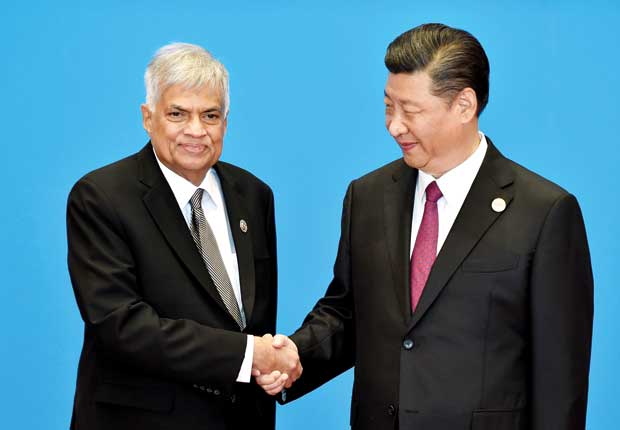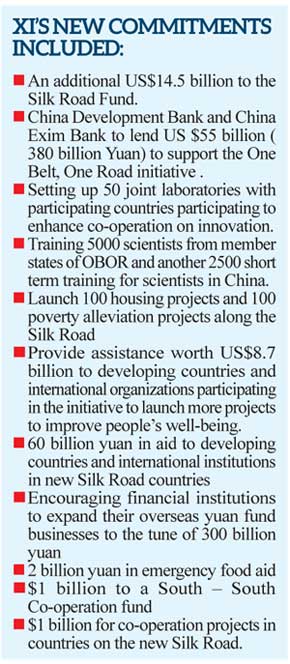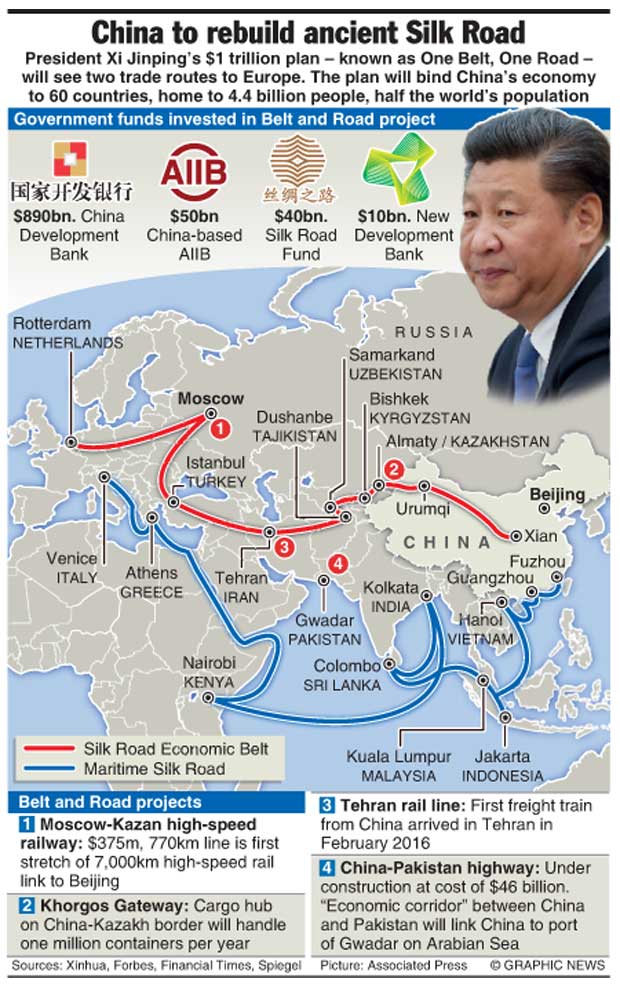Reply To:
Name - Reply Comment
Last Updated : 2024-04-26 22:10:00
During the last weekend, President Xi Jinping unveiled his pet project, presented in a rather confusing jargon, ‘One Belt One Road’, in Beijing. The next door communist neighbour, North Korea in a quirky brotherly fashion greeted the guests with fireworks. Test firing a missile, which it boasted as capable of carrying a large nuclear warhead, Pyongyang stole headlines from Mr. Xi.
But the caravan went on. By the end of the day, Mr. Xi announced an additional US $ 120 billion of Chinese commitment for the New Silk Road. China’s New Silk Road which was first mooted by Mr. Xi in 2013 and presented to delegates of 65 countries, including 29 heads of states and governments, last Sunday envisaged to build a network of modern infrastructure and port facilities across the land and sea lanes that stretched from mainland China to Europe and Africa.

By any account, China’s new initiative will be a money spinner. Some Chinese observers tend to draw a parallel with the Marshal Plan, the American initiatives to aid the recovery of post- war Western Europe. However, in some counts, the Marshal Plan fails in comparison, if the full scale of the Chinese ambitions is materialized. The Marshal Plan provided US $ 13 billion assistance ( US $ 160 billion in 2016 value) during its four years of operation. Whereas, Credit Suisse in a recent report estimated that as much as US $ 502 billion in infrastructure development assistance would be splashed out in 65 countries during the next five years under China’s Belt and Road initiative. 
All politics is local. Silk Road is no different. The Chinese economy is slowing down and its ‘new normal growth’ of 6.5 per cent of last year was achieved with the aid of monetary and fiscal stimulus which in effect further increased China’s looming domestic debt burden. Producer Price Index (PPI) has remained negative from 2012 to last year. Yield on investment of one Yuan on GDP has declined from 0.4 Yuan in the early 1990s to a paltry 0.07 Yuan as of 2016. By building infrastructure abroad, which themselves would link the Mainland with distant territories, China aims to kick start factories and construction industry- though at the domestic level, the most crucial reforms concentrate on re-balancing its export driven economy towards a consumer driven one.
There are geopolitical designs as well.Since Mr Xi’s advent to the helm of the Chinese Communist Party and ex-officio the presidency of China, Beijing has gradually shed its low key approach to international politics, which was best articulated by Deng Xiaoping’s dictum:‘ hide your colours, bide your time.’ China’s new found assertiveness in its neighbourhood, especially in the South China Sea eroded much of goodwill it cultivated with its neighbours, though Beijing at times had managed to buy it back from those like Philippine’s authoritarian president with the help of Red Yuan.
 The Belt and Road initiative is by far the most ambitious approach to project China’s new found clout beyond its traditional borders. There is a correlation between the increase of power of a state and its expansion. When a state grows in power, it expands beyond its borders.. Though the conduct of modern states has become more subtle, the underpinning logic remains the same. And what better time than now to do that?The reigning super power America is retreating inward and the EU is in disarray. But geopolitics of China’s design would continue to haunt. India and Japan, the two regional states that rival China for influence had been noticeably absent at the Summit, so was much of Europe, save Greece and Spain- the latter itself, many observers fear, is sitting atop a Greek styled looming bank default.
The Belt and Road initiative is by far the most ambitious approach to project China’s new found clout beyond its traditional borders. There is a correlation between the increase of power of a state and its expansion. When a state grows in power, it expands beyond its borders.. Though the conduct of modern states has become more subtle, the underpinning logic remains the same. And what better time than now to do that?The reigning super power America is retreating inward and the EU is in disarray. But geopolitics of China’s design would continue to haunt. India and Japan, the two regional states that rival China for influence had been noticeably absent at the Summit, so was much of Europe, save Greece and Spain- the latter itself, many observers fear, is sitting atop a Greek styled looming bank default.
Indian concerns are primarily emanating from China-Pakistan Economic Corridor (CPEC) that runs through the Pakistani administered Kashmir, over which India claims its sovereignty. “No country can accept a project that ignores its core concerns on sovereignty & territorial integrity,” India’s Ministry of External Affairs said in a statement announcing its boycott of the summit.
Japan’s nationalist Prime Minister Shinzo Abe also concerned about the growing Chinese influence is inching away from the Country’s Pacifist constitution and is searching for new strategic alliances, leading to a convergence of Indian and Japanese interests.
Mr. Wickremesinghe was in Beijing gracing the Silk Road Summit. He may have felt himself inconsequential in the presence of Mr Putin, the President of Russia and Turkey’s Erdogan, champions of the new normal of authoritarianism.
Mr. Wickremesinghe was expected to sign a Memorandum of Understanding with China on a host of development projects including the Hambantota Port and the proposed industrial zone in Hambantota. He earlier signed similar MoUs with Japan and India. Sri Lanka is desperate to sign up more development partners in order to lessen its dependence on China. However, earlier efforts to reach out to America and Europe came to a naught partly due to internal political turmoil in those countries and low strategic importance of Sri Lanka in their eyes. Sri Lanka also presents an opening for Japan as it seeks to redefine its strategic culture. However, the problem that beset Sri Lanka historically is that other than its strategic location in the Indian Ocean, it had very little as enticement to offer its prospective development partners.This may explain why we have failed to attract high end investment.A strategic location that is not exploited is no better than Victorian women’s virginity, perhaps a badge of honour, but of no practical utility.

However, if Sri Lanka manages to enlist one major country, others will follow for one’s gain would, over time, become the other’s loss. Recent Indian interest, in particular, and Japan’s to a lesser degree, in Sri Lanka is partly driven by increasing Chinese presence in the island. Indian development activity smacks of more of a balancing initiative of China, than of sheer economic logic, which can be understood in the trade- off that entails between India’s domestic economic imperatives and its external imperatives. By creating a level playing field for all these countries, Sri Lanka can maximize benefits for its people. That would also necessitate paying careful attention to India’s strategic concerns and addressing them forthwith.
Silk Road and its potential for high level infrastructure boom offer Sri Lanka an opportunity to build a platform that would attract the attention of other prospective development partners. Sri Lanka should view it as an opportunity to diversify, rather than one of dependence.

Add comment
Comments will be edited (grammar, spelling and slang) and authorized at the discretion of Daily Mirror online. The website also has the right not to publish selected comments.
Reply To:
Name - Reply Comment
US authorities are currently reviewing the manifest of every cargo aboard MV
On March 26, a couple arriving from Thailand was arrested with 88 live animal
According to villagers from Naula-Moragolla out of 105 families 80 can afford
Is the situation in Sri Lanka so grim that locals harbour hope that they coul

4 hours ago
6 hours ago